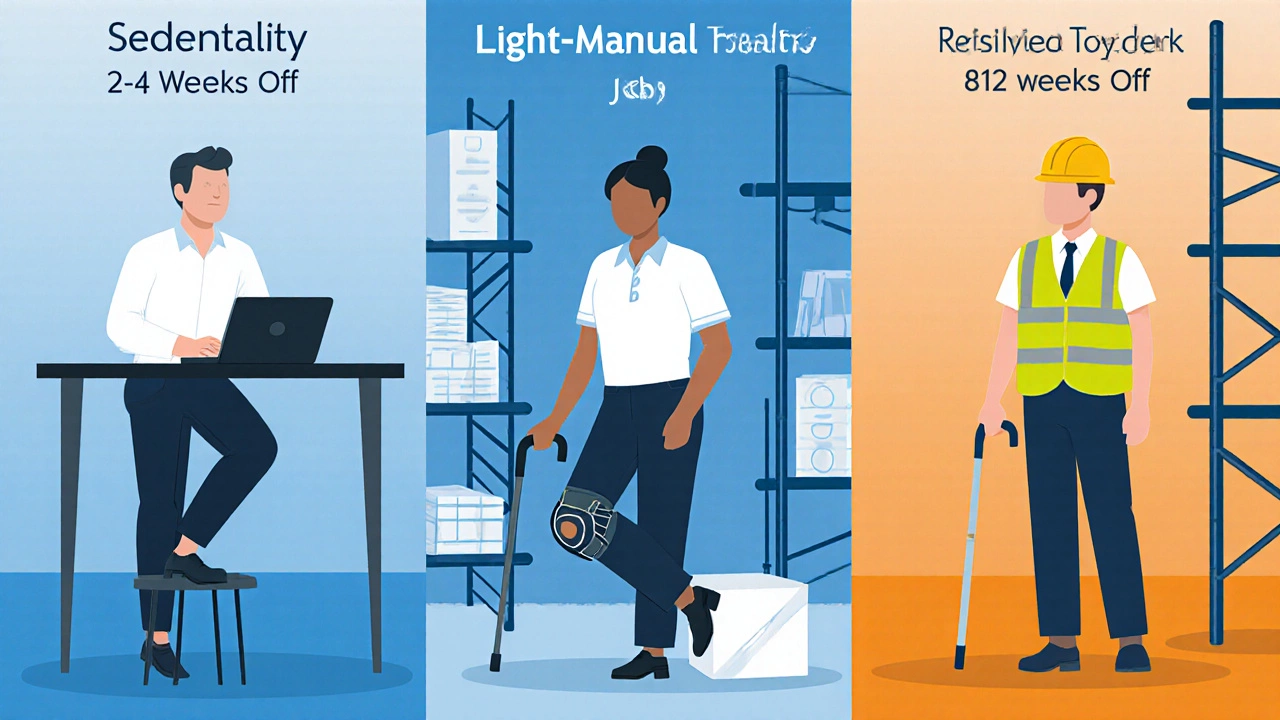Return to Work Calculator After Knee Replacement
Estimated Return to Work Timeline
weeks
This is an average estimate. Individual recovery may vary based on age, health, and rehabilitation quality.
Wondering how many weeks you’ll actually be away from the office after a knee swap? The answer isn’t a one‑size‑fits‑all number, but the data points to clear patterns that can help you set realistic expectations and plan ahead.
Total knee replacement is a surgical procedure that removes damaged cartilage and bone from the knee joint and substitutes them with artificial implants. It’s most often recommended for severe osteoarthritis, rheumatoid arthritis, or post‑traumatic damage. The operation typically lasts 60‑90 minutes, followed by a brief hospital stay of 2-3 days. Once you’re home, the real work begins - regaining motion, managing pain, and gradually getting back to daily tasks.
Recovery Milestones You’ll Hit After Surgery
The first few days focus on pain control and basic mobility. By the end of week 1, most patients can sit, stand, and walk short distances with a walker or crutches. Weeks 2‑3 bring gentle physical therapy structured exercises aimed at restoring range of motion and strengthening surrounding muscles. Around week 4, you’ll likely start moving without an aid, and by week 6 the knee should have enough flexion for everyday activities like climbing stairs.
Full functional recovery - meaning you can walk long distances, ride a bike, or play light sports - usually takes 3‑6 months. However, the point at which you can return to work often comes much earlier, depending on the nature of your job and the support you receive.
Key Factors That Shape Your Leave Duration
Not every knee replacement story unfolds the same way. Several variables swing the clock forward or backward:
- Job demands: A desk‑bound role with minimal standing is far easier to resume than a position that requires heavy lifting or frequent kneeling.
- Age and overall health: Younger patients with good cardiovascular fitness tend to heal faster.
- Pre‑existing conditions: Diabetes, obesity, or smoking can delay tissue healing.
- Complication risk: Infections, blood clots, or stiffness may add weeks to the recovery plan.
- Rehabilitation quality: Access to skilled occupational therapy targeted training that helps patients safely perform work‑related tasks can shave days off the timeline.
Understanding these elements lets you and your employer craft a realistic medical leave policy formal agreement outlining the length of paid or unpaid absence, accommodations, and return‑to‑work criteria that respects both health and productivity.

Average Time Off Work by Job Category
Data from orthopedic clinics and employee health surveys show the following typical ranges:
| Job Type | Typical Weeks Off | Key Considerations |
|---|---|---|
| Sedentary job roles that involve mostly sitting, like office work or computer programming | 2‑4 | Focus on knee brace comfort and short walks to the restroom; can start light desk duties after week 2. |
| Light‑manual job tasks such as retail stocking, light assembly, or teaching | 4‑6 | Requires gradual reintroduction of standing and light lifting; may need modified duties. |
| Manual labor jobs that involve heavy lifting, kneeling, or prolonged standing, e.g., construction, farming | 8‑12 | Full ergonomic assessment and possibly a temporary reassignment; brace may be worn for 6‑8 weeks. |
| High‑impact sports/professional athletes | 12‑24 | Intensive rehab, progressive loading, and stricter criteria before returning to full activity. |
These numbers are averages; individual experiences can vary. The goal is to avoid rushing back too early, which increases the risk of re‑injury or prolonged pain.
Real‑World Stories: How People Managed Their Leave
Rita, a 52‑year‑old marketing manager, returned to her desk after just three weeks. She worked with a knee brace a supportive device worn post‑surgery to protect the joint while it heals and scheduled brief standing breaks every hour. Her employer approved a flexible schedule, allowing her to start with half‑day shifts.
On the other side, Raj, a 45‑year‑old carpenter, needed nine weeks before he could lift a 20‑kg bucket. His contractor arranged a temporary assignment in the workshop office, letting him handle paperwork while his knee regained strength through prehabilitation pre‑surgical conditioning exercises that improve postoperative outcomes and early physical therapy sessions.

Tips to Shorten Your Time Off Work
While you can’t control every factor, you can influence many aspects of recovery:
- Start prehab early. Strengthening the quadriceps and improving knee range of motion before surgery boosts postoperative progress.
- Communicate with your employer. A clear medical leave policy outlining phased return‑to‑work reduces anxiety.
- Follow the therapist’s plan. Consistent physical therapy reduces swelling and restores mobility faster.
- Manage pain wisely. Use prescribed analgesics as directed and incorporate ice and elevation to keep swelling down.
- Stay active within limits. Short walks, stationary cycling, and gentle stretching keep blood flowing and prevent stiffness.
By integrating these habits, many patients find they can return to light duties on the lower end of the typical range.
Frequently Asked Questions
How soon after surgery can I sit at a desk?
Most surgeons allow patients to sit in a chair for short periods by the end of week 1, provided pain is controlled and the knee is supported with a brace.
Will my employer have to provide a modified workstation?
If the job requires prolonged standing or heavy lifting, a temporary ergonomic setup - like a sit‑stand desk or reduced load - is often recommended under occupational health guidelines.
Can I travel for work during recovery?
Short trips are generally fine after the first two weeks if you can move comfortably and have a brace. Long‑haul flights or extended walking should be postponed until week 6‑8.
What if I experience swelling after returning to work?
Increase ice application, elevate the leg during breaks, and contact your therapist. Persistent swelling may signal over‑exertion and could require a brief pause.
Do insurance plans cover the time off I need?
Many policies cover a portion of short‑term disability benefits. Check your employer’s benefits handbook and discuss the expected leave duration with your HR department.
Knowing the typical timelines, the factors that shape them, and practical ways to speed up recovery lets you plan confidently. Whether you sit at a desk or swing a hammer, the goal is a safe, steady return to work while keeping your new knee healthy.






